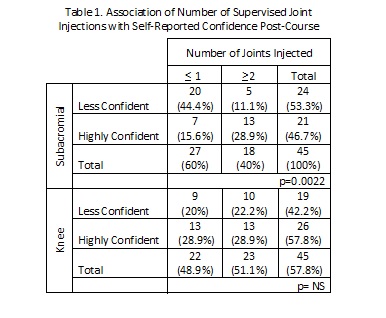Session Information
Date: Monday, November 9, 2015
Title: Education Poster I
Session Type: ACR Poster Session B
Session Time: 9:00AM-11:00AM
Background/Purpose:
Developing
confidence in procedural skills is an important aspect in improving procedural
competency. Although a number of studies have explored effective methods to
teach arthrocentesis, the relationship between the number of injections
performed and confidence in injection skills has not been researched. We investigated
the number of subacromial (SA) and knee injections required for a learner to
become confident in procedural skills.
Methods:
Internal
Medicine (IM) interns at our program participate in a week-long musculoskeletal
skills course that takes place at a VA Medical Center. The course is open to
post-graduate residents of other specialties. During the course SA and knee injection
techniques are introduced through didactics and reinforced through simulation, peer-teaching and supervised
ambulatory experiences. A total of 45 trainees participated in the course in
2014-15 (IM (32), physical medicine & rehabilitation (6), occupational
medicine (5), orthopedics (2)). The number of SA and knee injections performed
by each trainee was tallied. Before and after the course participants used a
5-point Likert scale to rate confidence in performing joint injections. Data were
divided into two categories for analysis (1-4 = less confident, 5 = highly
confident). Chi squared analysis was used to compare the number of injections
performed versus post-course self-assessment of confidence.
Results:
In
addition to simulator training, trainees performed an average of 1.1 SA
injections (range 0-3, median 1) and 1.6 knee injections (range 0-5, median 2).
Mean confidence
scores markedly increased from 2.4 pre-course to 4.5 post-course for SA
injections and from 2.7 to 4.3 for knee injections. Of the participants who
started as less confident in SA injections, only 1 (2%) decreased in confidence;
5 (11%) did not change. Of the participants who started as less confident in
knee injections, only 1 (2%) decreased in confidence; 2 (4%) did not change. Table
1 shows association between the number of supervised joint injections performed
and self-reported confidence post-course.
Conclusion:
Our
MSK course increased confidence in performing SA and knee injections. Participants
who performed at least 2 SA injections had a statistically significant
association with ranking themselves as highly confident post-course. There was
no statistical significance association between the number of knee injections
performed and self-assessment as highly confident post-course. Our next step
will be confirming that the self-assessment of confidence is valid by comparing
scores to external measures (e.g. objective structured clinical exam).
To cite this abstract in AMA style:
Jaffe E, Barker AM, Cannon GW, Beck JP, Battistone MJ. Comprehensive Musculoskeletal Course Improves Post-Graduate Trainees’ Confidence in Performing Joint Injections [abstract]. Arthritis Rheumatol. 2015; 67 (suppl 10). https://acrabstracts.org/abstract/comprehensive-musculoskeletal-course-improves-post-graduate-trainees-confidence-in-performing-joint-injections/. Accessed .« Back to 2015 ACR/ARHP Annual Meeting
ACR Meeting Abstracts - https://acrabstracts.org/abstract/comprehensive-musculoskeletal-course-improves-post-graduate-trainees-confidence-in-performing-joint-injections/

